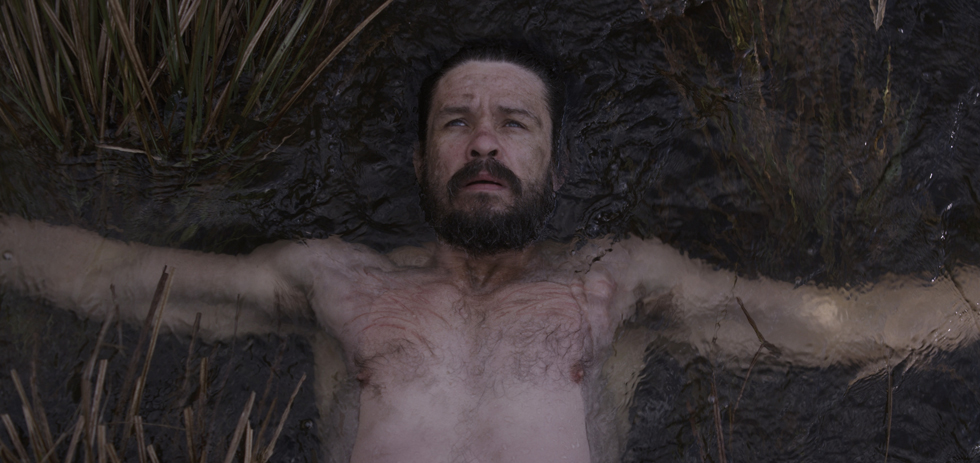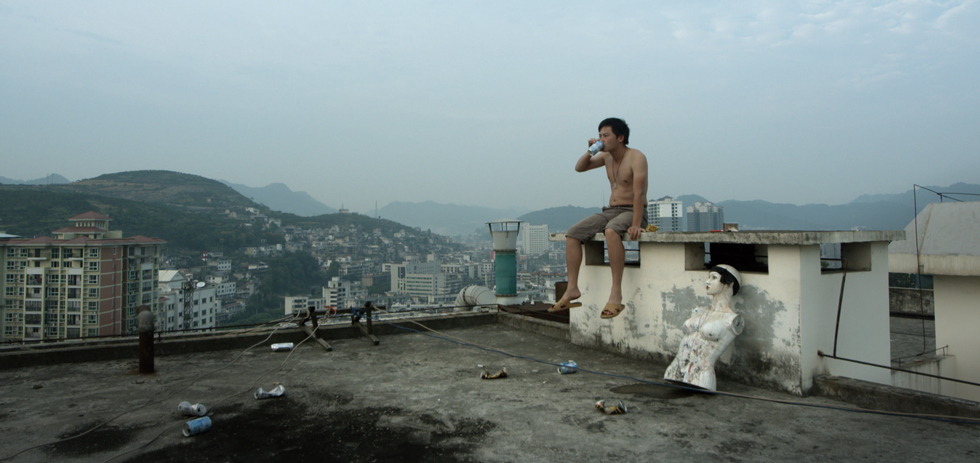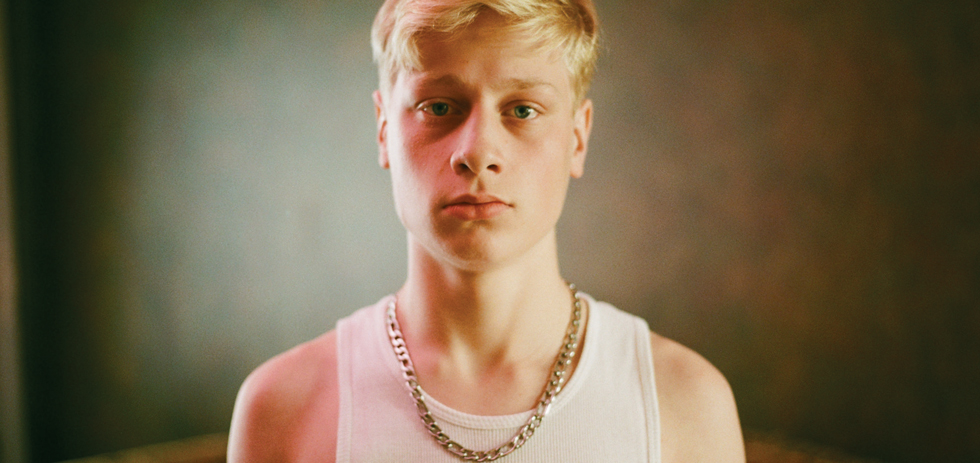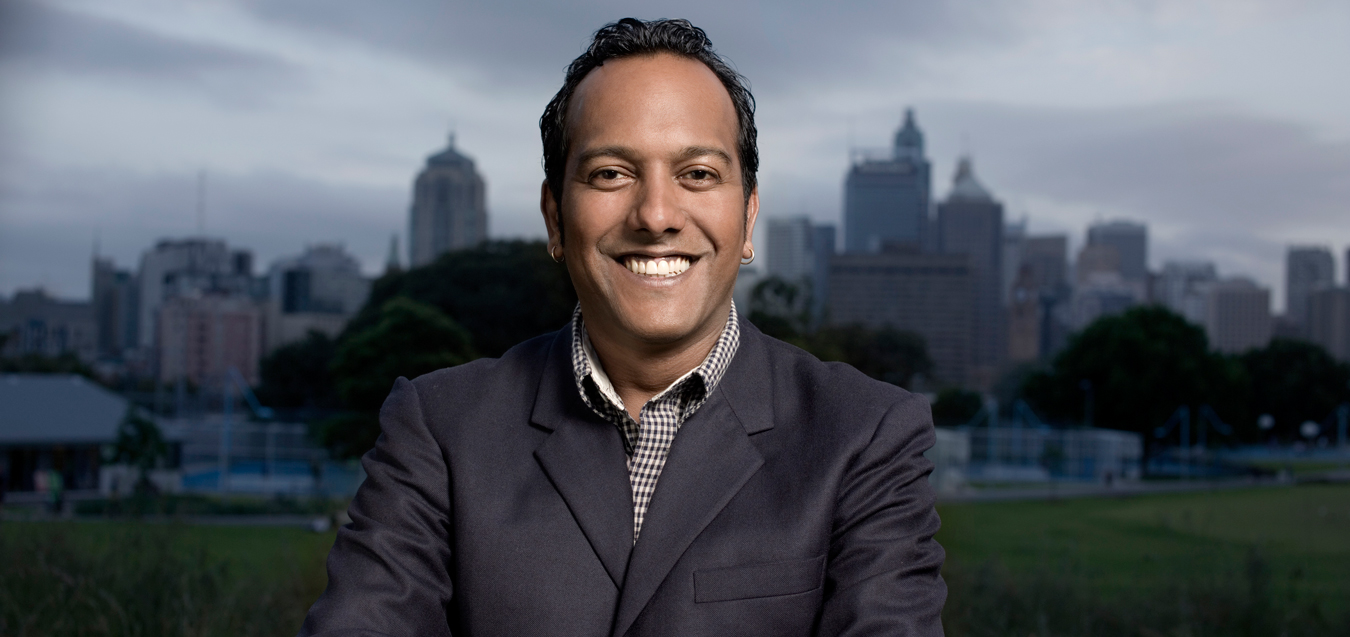Nashen Moodley is the Festival Director of Sydney Film Festival and has held that role since 2012. This year marks his third festival at the helm. We caught up with him this week in the lead-up to Opening Night on the 4th of June.
Congratulations on a really good program, it looks great this year. The competition seems a lot darker, I think. Now that I have seen Boyhood I know that there is some hope but, on the whole, it seems very much like a series of films focused on doing something new with cinema rather than relying on convention or emotional triggers.
I think that’s true to an extent, I think a lot of the films are pretty dark, or appear to be but they are more complex than that. For instance, I think The Kidnapping of Michel Houellebecq is hilarious, I think it’s one of the funniest films of the festival – I don’t know if everyone will agree with me on that but that’s what I feel. I think a film like Kumiko, the Treasure Hunter is quite sad but at the same time has this whimsy and even moments of humour to it —
— well, the rabbit —
– yes the rabbit, Bunzo, is great. I think it’s not as simplistic as saying they’re all dark. I think there is more going on and I think that it’s interesting that you say that there isn’t a commercial trigger, and I understand completely what you mean by that, but when I think you look at films like Snowpiercer, that is a sci-fi film that is playing with genre in a way; Ruin is a road movie, but a very different one.
I think the comparison I was trying to make was to films from last year like Wadjda and The Rocket, that tend to fall into deceptively simple narratives. All of these ones, at least the way that they are being marketed, you know that you’re in for something.
I think that there’s a lot more formal experimentation in this year’s competition films. That said, last year something like The Act of Killing or Stories We Tell were very formally experimental, formally unusual.
Well with those two films last year, and 20,000 Days on Earth this year, what relationship do you think documentary cinema has with the Official Competition? Do you feel obliged to include some each year?
I don’t think the two documentaries last year were straight up documentaries, though, and I also don’t think about whether we have to have a documentary or two in the competition. It’s really a question of whether I feel that the competition is the right place, the perfect place for a film, then it will go on to the competition. Jenny (Neighbour, the SFF Programs Manager and Documentary Programmer) selects the documentaries for the festival and I speak to her about what is really interesting from the documentaries, and have seen many of the documentaries in this year’s selection. But something like 20,000 Days on Earth I saw at Sundance and knew immediately we had to have it for the competition.
On the documentaries, this may be more a question for Jenny, but this year has one of the strongest documentary line-ups I think the festival has ever had, as cliche as it sounds it does look like there’s something for everyone. You’re covering everything from experimental cable car journeys as cultural survey in Manakamana to something as straight forward as Tim’s Vermeer.
I think people have reacted well to the whole program, even before we announced these late additions – all of which are very special films.
Was there any desire to slip say, Winter Sleep or Mommy into the Official Competition at the last second?
Well, we can’t – we’ve made a full schedule for the State Theatre, it’s not possible. Again, though, I think those films have made a huge impact already and they’re gonna be ok.
With the competition as well, last year you had one Australian film in the competition and now you have three, do you think you’re making any statement about the direction or quality of Australian cinema?1
I don’t think these things happen like that, on a year to year basis, it’s not –
-it’s not wine.
Yeah, you know it’s also dependent on timing and which Australian films are ready. So some years we don’t have so many to pick from and in others we have a lot. I think these three films, individually, really belong in the Official Competition and nowhere else. Ruin I’ve been tracking for well over a year – there was the hope that they’d finish the film in time for last year’s festival but that didn’t happen. The Rover of course we’ve been hearing about for a long time and Fell, I knew about when it started shooting last year in July. These are all films we were waiting for and, when the time came and I finally saw them, it was just obvious to me that they should each be in the competition.

I want to talk about Fell because it is a world premiere. You have a world premiere in the Official Competiton by a graduate of the VCA and no one has heard anything about it.
Well that’s the exciting thing!
There’s a weird, mythic quality about it knowing that this world premiere is in the Official Competition next to the latest film by Richard Linklater and the Golden Bear winner, Black Coal, Thin Ice.
The pressure’s on Kasimir Burgess and I guess, to an extent, it’s also on me. (laughs) I think he’s an extraordinary talent, I think the film is really great. Of course, there is pressure when we put the film in the competition but that’s where I feel it belongs. At the end of the day, people may love or hate any of the films in the competition but I want people to understand why a film is in there and I think they will. Certainly, I don’t expect everyone to love every film in the competition and I think the competition has to be risky at times, otherwise it just becomes a safe place for films that will sell 2000 seats, which is not what the Official Competition is about.
Do you feel that you have an obligation through the competition to showcase what you see as the future of cinema? It’s a very idiosyncratic thing, picking the competition because it reflects what you think moreso than anything else. For instance, you yourself have said that The Kidnapping of Michel Houellebecq will most likely divide audiences.
Probably.
Do you think, for that film, people should have read his books to fully appreciate it?
I think that it would help but I don’t think it’s completely necessary. I think you’ve got to have some understanding of who he is but the film reveals a lot about him. I think it’s enough, at a basic level, to know that he’s a famous and controversial writer and that he’s playing himself in the film.2
So, back to the competition, I know that you often refer to them as your favourite films of the festival, but do you also think that people need to see them to get or understand cinema today?
To an extent but we are bound to have 12 films in competition, out of 200 films in the festival. I think if people want to see what cinema is today, they need to watch 200 of the films, or at least a large portion of them. I have to love the films that make the competition but they also have to fulfil a certain criteria that we have, they have to be daring and cutting edge, taking chances and somehow taking the art form forward. There are films outside of the competition that are very important and that I love very much as well. However, I will say that I think very deeply about which films make the competition.
Well the competition is a reflection of you, in a way. It’s this weird eclectic series thrown together without thematic constructs; it is just what it is.
That’s an interesting point. Well, in my first year at the festival, there was a film that Richard Kuipers wanted to program in Freak Me Out and I said to him “No Richard, I’m putting that in the competition”.
Which film was that?
That was The King of Pigs, by Yeon Sang-ho. His latest film, The Fake, is screening at the festival this year.
We had an interview with Richard a few days ago, actually, and he said that one of his favourite things about programming Freak Me Out was getting this horror fan filled-audience, who always go to the Freak Me Out films, and screening something like End of Animal and have them experience something completely different. He said that it was so rewarding having them come up to him afterwards and say how much they enjoyed that film. Is that, in a sense, how you approach the competition? You know that people will always see the competition films but actively programming to make people see things that are different?
Absolutely. You know that with some films people will seek them out no matter where they are in the festival, there are certainly some of them in the competition this year. But certainly something like Gangs of Wasseypur, which I was really happy to present at the festival a couple of years ago, that was not a film people would have ordinarily seen, certainly not in the numbers they did at the festival.
That was a great movie.
It is great and it’s great to be able to surprise people in that way and I think that this is an audience really open to surprises. Close to 1000 people watched Gangs of Wasseypur, which is five-and-a-half hours.
Well now you also have TV series screenings at the Festival.
Yes, last year we had Burning Bush and Kiyoshi Kurosawa’s Penance.
So you are looking at programming more longform stuff that breaks with form.
Yes. It’s sometime daunting for us as well – is an audience gonna watch this film? – that’s definitely in consideration with a film like ‘Til Madness Do Us Part, which is around four hours long.
And Winter Sleep is three hours long, on the final day no less.
There’s always an element of risk that seems to go with screening films like that and I think it’s fantastic. I was once on a festival jury in Rotterdam with a wonderful Phillipino filmmaker, Lav Diaz, who often makes films around 9 or 12 hours long and we were in jury meetings and every hour or so, he would go and run off and come back. And I would say “Lav, what are you doing?” and he would say “well I’ve got to go make sure they change the tape because projectionists always fall asleep during my movies”. So he goes and makes sure the tape is changed and would give me a running update during the day. The film started with 100 people, then he would run back and there would be still 60 left and then by the end of the day there would only be 20 left. But those 20 people are heroes.
Going off of Wasseypur and moving from there, there seems to be a greater focus on Asian cinema since you took over the festival. You had Gangs of Wasseypur in the 2012 competition, Monsoon Shootout and The Rocket last year and now Snowpiercer and Ruin. There seems to be, in a good way, a focus from Sydney on our immediate neighbours in terms of their film cultures. You’ve got the ‘Focus on China’ in this year’s festival. What was the impetus for that?
Well I’ve always been particularly interested in Asian cinema and I guess that’s why there’s perhaps a bigger focus on Asia in recent years. Going back to the early days of Sydney Film Festival, though, there was a very strong focus on Asian cinema and even more recently, I think Asian cinema has had a very prominent place in the festival and it’s nice to get back to that. The ‘Focus on China’ – Each year I think about what’s going to be exciting, what’s really going to be interesting this year. It’s difficult to predict and sometimes I might have an idea and it doesn’t quite pan out. With Austria last year, I knew that Ulrich Seidl’s Paradise trilogy would be completed by June and I thought, well, he’s one of my favourite filmmakers, I’d love to show all three Seidl films and that opened up a good opportunity to do a focus on Austrian cinema last year, and also of course Haneke won the Oscar that year, which gave Austrian cinema a lot of attention. With China, I think I knew there were going to be a lot of great Chinese films this year, Berlin had three Chinese films in the competition, which is unusual, and a Chinese film won the Golden Bear but we had decided on the Chinese focus before then actually. I think China is one of the world’s most interesting cinema producing nations but also increasingly becoming one of the largest cinemagoing nations.

There’s the big shift in Hollywood now to incorporate China in their productions, like Looper and Her.3
So we wanted to take the opportunity to show what is going on in Chinese cinema and, as far as we could, show a range, from fairly big budget mainstream films to kind of arthouse faire to indie comedies to very serious and independent documentaries. It’s a small selection of course in relation to China’s output, but it’s what we can do with it in the festival context. I think if someone was to watch all of the Chinese films in the festival, both Black Coal and the Chinese focus, they will have some idea of what is going on in Chinese cinema. It’s a stepping stone for them to discover more.
The idea that back in the 1960s Sydney Film Festival had a big focus on Asia, it feels like by screening something like Charulata as a restrospective, it’s this return or looking back at the festival, because of Satyajit Ray’s place in Sydney Film Festival history.
I think the retrospective classics are mostly about what’s being restored when.
I think it has to be because there doesn’t appear to be any thematic link between Rebel Without a Cause, Hiroshima mon amour, Charulata and The Texas Chain Saw Massacre.
(Laughs.) You know we had a few ideas about this and my initial idea was to only play films that had played in the festival before but from decades ago. Then I knew about this restoration of Rebel Without a Cause and then you look optimistically at this list of over 8000 films and hope they played Rebel Without a Cause. Of course, though, they didn’t play Rebel Without a Cause. Charulata is different, they did play that and Ray came out to the festival. The Texas Chain Saw Massacre never played here –
– but Tobe Hooper’s first short film did.
Oh yeah! But mostly we went with films that we liked and wanted to see again.
That’s similar to the approach at Cannes, right?
Yes, it all comes down to what’s being restored and what’s available. Hiroshima mon amour we are screening because Resnais passed away earlier this year and we wanted to pay tribute to this great filmmaker. I do like the flexibility of being able to look at what’s out there and see what makes sense for us. Before we secured Boyhood we were going to screen the documentary Double Play, about Linklater and James Benning. Then, when we secured Boyhood, which we were very excited about as you can imagine, we thought, well, Double Play is very much about the relationship between Linklater and James Benning and people have not been so exposed to Benning’s work, so let’s do a minor retrospective of Benning’s work – just a small collection of his works – and then Benning said he’d like to come, so then of course we were absolutely delighted.
I imagine it helped that Austria seems to love Benning, their Filmmuseum has restored his films and that’s where you’ve got some of these prints. I actually think that, perhaps by accident, having Benning’s American Dreams (lost and found) in the same festival as Linklater’s Boyhood, is a great thematic overlap because both play with history and memory.
I think that maybe the explanation for that is also that Linklater and Benning do have such a close friendship and it’s not one that you would first imagine. Linklater has shown Benning’s works when he ran the Austin Film Society, so I think maybe they’re not so different as you might imagine and the thematic connections you see are there, that it is something they themselves might recognise or see in each other.
With the idea of a retrospective itself, do you feel that the festival has an obligation to educate on the past as much as show cinema today?
I think that with our retrospectives and restorations, clearly our position is to expose people to these films from the past and we always see it as fulfilling two objectives. One, there is going to be a certain element of nostalgia, people who saw Rebel Without a Cause when they were kids and might really want to see it again on the big screen but we also want, you know, eighteen year-olds who have never seen the film before, or certainly never on the big screen, to see it because it is important.
So the retrospectives are, to some extent, about exposing people to important cinema they wouldn’t otherwise get? There’s no real film societies in Sydney anymore outside of the Chauvel Cinematheque and the Art Gallery of New South Wales. That’s it. The festival existing, then, is vital, in a way, to promote these older films but also to screen films on 35mm. Let me phrase it this way – I’ve noticed this is the first festival ever to not screen anything (outside of retrospectives) on actual film – do you think that it is a good thing that the Sydney Film Festival has stopped projecting on celluloid film?
I don’t know if it’s a good thing for the festival, it’s certainly not a bad thing for the festival. I guess on one hand it’s cheaper in terms of the freight but I miss 35mm, I really do. When I see things perfectly projected on DCP, I understand completely why it’s great, it can be really stunningly beautiful. You don’t need rope lines on a new film by Andrey Zvyagintsev, for instance, it’s quite beautiful and crisp.
You also don’t need people, though. With an actual projector there’s a possibility for mistake or adjustment in a way that makes the process more organic, to some extent.
I think people make mistakes with DCPs as well! (Laughs) It’s very tough for me to say, well, I’d say it’s not worse for the festival that we don’t have any 35mm films projected at the State. I do think it would be wonderful to have a slight combination of the two but it’s just not possible. You never know, there can be surprises. For instance, The Rocket last year, we had a DCP, we ingested the DCP, it looked fantastic, it sounded great. Kim (Mordaunt), the director, said “I have a 35mm print coming in tomorrow from Thailand” and we said that there was no way that it would look better than the DCP and he said “No, I think the print will look better”. So we arranged to have the print made up and we looked at both and the print looked better, it had a certain richness to it, for that film. I’m not saying film prints look better for every film but he was completely right, of course. We screened that film on 35mm in the festival. We though last year we would have no 35mm but we did. In some countries they still produce 35mm film prints, I think Thailand, India and Japan.
Would you like to see, or encourage, competition films to be screened in 35mm?
Not every filmmaker wants their films projected in 35mm. There will be some, sure, but not all. You always project as the filmmaker desires.
One final line of questioning – it seems than since you’ve been in charge of the festival it’s gotten a lot more, let’s say, youthful –
– it’s because I’m so young (laughs).

Naturally. But it seems like a lot of the program now appeals to students. Not in the sense of more films starring an 18 year old but thematically and in terms of the directors chosen. Having two Xavier Dolan films is a big deal for university students.
Well, I’d like more students to come to the festival, of course. I think they are a natural target audience for us. I think it’s really terrible for us that we’re scheduled at the same time as many universities’ exams, which is really a cruel twist of fate and that’s not my doing. Of course I want the festival to appeal to young people. We want more and more of them to attend the festival – it’s for them as much as it is for anyone. The audience has been growing younger, we are bringing in more young people each year but I want more and more to come. To an extent, yes, when we make the program we think about appealing to as diverse an audience as possible but I don’t feel like I am making compromises to attract younger people to the festival. For me, having the two Dolan films is not a compromise at all, it’s a wonderful privilege.
I guess I first programmed Dolan when I, when was it… When I was in my twenties, – no I was in my early thirties – he’s just made five films in five years! For me, when I saw the first Dolan film, it was really incredibly exciting for me. It was like I’d seen something wonderful and new. So I guess he’s as much a hero for me, and I feel like we’ve kind of grown up together even, as it would be for a younger person discovering him for the first time now – it’s incredibly exciting.4
Thank you very much for your time.
Oh we just blathered for a long time. Thank you.
Sydney Film Festival opens on the 4th of June and continues until the 15th. Tickets can be purchased here.
Disclosure: Conor Bateman worked for Sydney Film Festival in 2013
